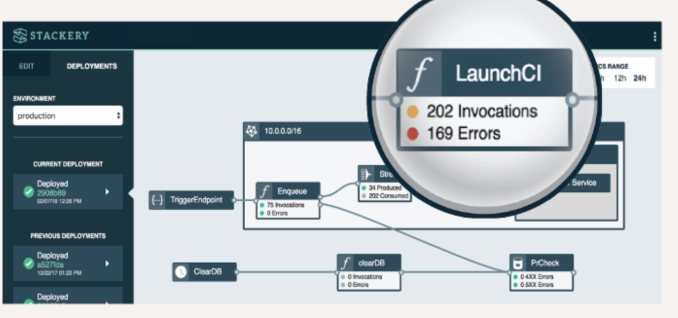When Stackery’s founders were still at New Relic in 2014, they recognized there was an opportunity to provide instrumentation for the emerging serverless tech market. They left the company after New Relic’s IPO and founded Stackery with the goal of providing a governance and management layer for serverless architecture.
The company had a couple of big announcements today starting with their $5.5 million round, which they are calling a “seed plus” — and a new tool for tracking serverless performance called the Health Metrics Dashboard.
Let’s start with the funding round. Why the Seed Plus designation? Company co-founder and CEO Nathan Taggart says they could have done an A round, but the designation was a reflection of the reality of where their potential market is today. “From our perspective, there was an appetite for an A, but the Seed Plus represents the current stage of the market,” he said. That stage is still emerging as companies begin to see the benefits of the serverless approach.
HWVP led the round. Voyager Capital, Pipeline Capital Partners, and Founders’ Co-op also participated. Today’s investment brings the total raised to $7.3 million since the company was founded in 2016.
Serverless computing like AWS Lambda or Azure Functions is a bit of a misnomer. There is a server underlying the program, but instead of maintaining a dedicated server for your particular application, you only pay when there is a trigger event. Like cloud computing that came before, developers love it because it saves them a ton of time configuring (or begging) for resources for their applications.
But as with traditional cloud computing — serverless is actually a cloud service — developers can easily access it. If you think back to the Consumerization of IT phenomenon that began around 2011, it was this ability to procure cloud services so easily that resulted in a loss of control inside organizations.
As back then, companies want the advantages of serverless technology, but they also want to know how much they are paying, who’s using it and that it’s secure and in compliance with all the rules of the organization. That’s where Stackery comes in.
As for the new Health Metrics Dashboard, that’s an extension of this vision, one that fits in quite well with the monitoring roots of the founders. Serverless often involves containers, which can encompass many functions. When something goes wrong it’s hard to trace what the root cause was.

Stackery Health Metrics Dashboard. Photo: Stackery
“We are are showing architecture-wide throughput and performance at each resource point and [developers] can figure out where there are bottlenecks, performance problems or failure.
The company launched in 2016. It is based in Portland, Oregon and currently has 9 employees, of which five are engineers. They plan to bring on three more by the end of the year.
from TechCrunch https://ift.tt/2H4ZBYd
via IFTTT

0 comments: